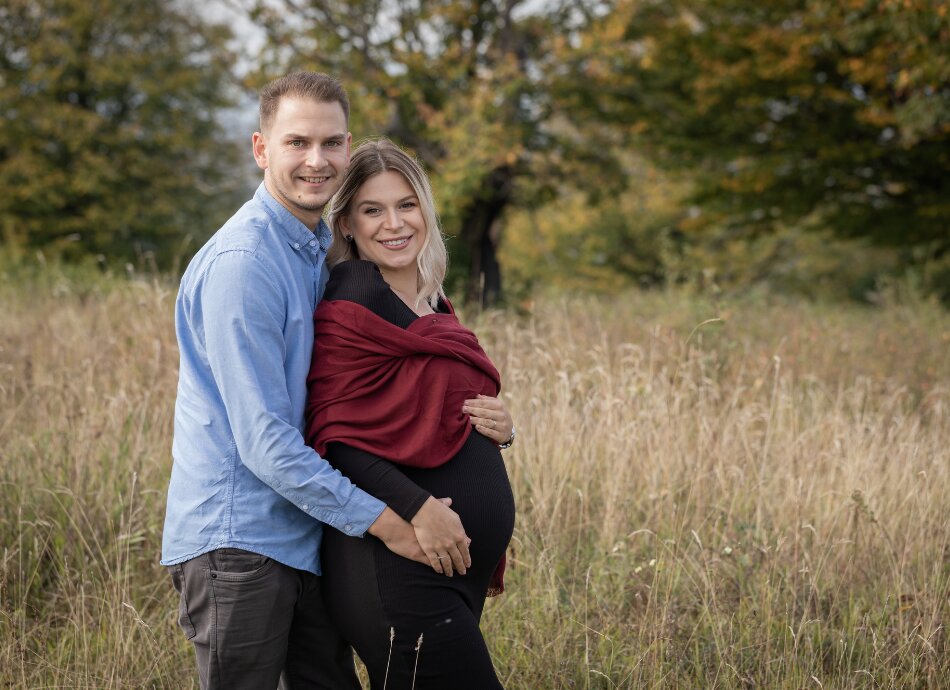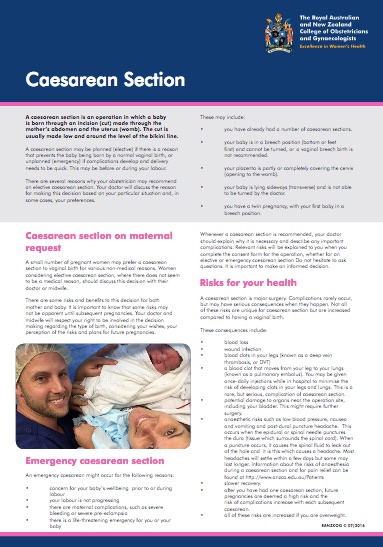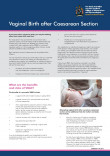Wishing everyone happy holidays and a joyful New Year from the Healthify team. Don't forget to Slip, Slop, Slap and Wrap!
Caesarean section
Key points about caesarean section
- A caesarean section (C-section) is an operation in which a cut is made through your abdomen (tummy/puku) to your womb (wharetangata) to deliver your baby (pēpē).
- It may be a planned (elective) caesarean or an emergency caesarean.
- A caesarean section is usually carried out using regional (spinal or epidural) anaesthetic.
- Caesareans are frequently performed, but there are risks and it can lead to complications.
- In the next pregnancy after a caesarean section, most women can have a natural vaginal birth.

A caesarean section, or C-section, is an operation in which a cut is made through your abdomen (tummy/puku) to your womb (wharetangata) to deliver your baby (pēpē). It's usually carried out using regional (spinal or epidural) anaesthetic.
You may have a planned (elective) caesarean if it's thought that going through labour may be dangerous for you or your baby, or an emergency caesarean if immediate delivery of your baby is needed because of complications that happen during pregnancy or labour.
You can usually have a natural vaginal birth if you have another pregnancy after a caesarean section.
Video: Your Caesarean Section
This video may take a few moments to load.
(National Women's Health, ADHB, NZ, 2018)
A caesarean section can be a planned (elective) caesarean section or an emergency caesarean section.
Planned or elective caesarean section
A planned or elective caesarean section is when your operation is planned before labour. This is usually recommended by your doctor or obstetrician when your doctor or midwife thinks that labour is dangerous for you or your baby/pēpē. This could be because:
- You have a condition called placenta praevia. The placenta is blocking your cervix (the entrance to your womb) so your baby can't be delivered through your vagina.
- You have had a previous caesarean section, and vaginal birth is not considered safe by your doctor or midwife.
- Your baby is premature or not growing well, and not likely to cope with the stress of labour.
- Your baby is in the breech position (feet first) or transverse position (lying across your puku/abdomen).
- You have pregnancy-related high blood pressure (pre-eclampsia) (however, many people with high blood pressure are still able to birth vaginally).
- You have a serious medical condition and it is safer for you to have a caesarean.
- You have had previous surgery to your womb.
- You have a genital infection at the start of labour, eg, genital herpes.
Emergency caesarean section
An emergency caesarean section is when your operation is carried out urgently or in a hurry, usually in labour, without being planned in advance. This can happen when delivery is needed immediately due to complications that happen during pregnancy or labour and the safest option is to deliver the baby straight away.
Examples of when an emergency caesarean section is needed include the following:
- Your labour is not progressing as expected and your cervix is not dilating (opening up).
- Your baby is showing signs of distress from the pattern of its heartbeat.
- You have excessive bleeding before or during labour.
- You develop serious complications of pregnancy-related high blood pressure.
- Your baby was not able to be delivered with the help of instruments like forceps or a venteuse (a suction cup attached to your baby's head to help your doctor or midwife gently pull your baby out).
- You have gone into labour before your planned caesarean elective caesarean date.
A caesarean section is usually carried out with regional anaesthesia. However, you may have either regional anaesthesia or general anaesthesia for a caesarean section. Your doctor or anaesthetist will discuss these options with you before your operation and make a decision based on your situation. Sometimes during an emergency situation a long discussion may not be possible.
Regional anaesthesia
With regional anaesthesia, you are awake during the operation. Just the lower part of your body is numbed so that you can still talk or respond to your doctor during the operation. There are 3 types of regional anaesthesia:
- spinal – this can be used in a planned or emergency caesarean section. The anaesthetic is injected into the spinal fluids surrounding the nerves in your back using a fine needle.
- epidural – a thin plastic tube or catheter is placed in your back outside the spinal fluids throughout the operation so that anaesthetic can be topped up if needed. This is usually used as a pain relief in labour.
- combined spinal epidural – both spinal and epidural are combined and given together.
If you have regional anaesthesia for your caesarean section, a support person can stay with you during the operation.
General anaesthesia
With general anaesthesia, you will be asleep throughout the operation. General anaesthesia is less common. Your doctor or anaesthetist will advise if general anaesthesia is needed in your situation.
If you have general anaesthesia for your caesarean section, your support person cannot go into the theatre with you.
Read more about anaesthesia.
Before your caesarean section
If you are having a planned or elective caesarean section, you will have a preoperative appointment to discuss this. You will be asked questions about your health, pregnancy, medical history and home circumstances. Your options will be explained to you and you will be told why a caesarean section is recommended. Sometimes some investigations, such as blood tests, may be carried out.
Your anaesthetic options will be discussed and explained to you. You will receive information about what will happen on the day of your caesarean, including when to stop eating and drinking, and the time that you need to come to the hospital. You will likely be given some tablets to neutralise tummy acid to take the night before and on the morning of your caesarean.
This is an opportunity to find out as much as you can about what is involved in your caesarean. You might want your partner, whānau or a support person to come with you to your appointments. This is so they know what is happening and can support you. Ask questions about what to expect during or after your caesarean.
On the day of your caesarean section
You will be given a time to come to the hospital on the day of your caesarean section. You can bring your partner/support person with you to the hospital and they can stay with you throughout the procedure, including during the operation, if you are having regional anaesthesia.
It is important to follow the instructions given to you at your preoperative appointment:
- Stop eating and drinking 6 hours before your caesarean section (except water).
- Stop drinking water 2 hours before your caesarean section.
You will be shown where to get changed and given somewhere to put your belongings. Your blood pressure and pulse will be checked and your baby’s heart beat will be listened to.
In the operating theatre
It will seem as though there are a lot of people in the operating theatre. They are there to keep you and your baby safe and each has their own role. In theatre there will be the surgeon (obstetrician) and their surgical assistant, the anaesthetist and anaesthetic technician, theatre nurses and midwives. There may also be paediatricians present to care for your baby.
You will have equipment attached to you to check your blood pressure, heart rate and the oxygen levels in your blood during the operation. A line or drip into your vein will be set up to give you fluid.
Your anaesthetist will make sure your details are correct and explain the procedure before giving anaesthetic to you. If you have regional anaesthesia, you will be asked to sit up at the end of the bed and drop your shoulders down to open up the space in your back. A local anaesthetic injection will be given to numb the skin on your back. Then, the regional anaesthetic will be given to you through a fine needle into your back.
The staff in the theatre will then help you to lie on the bed and do a few more checks before performing your operation. You will also have a urinary catheter inserted to drain urine from your bladder. The catheter will be removed after your caesarean.
The following video by National Women's Health at Auckland DHB gives you an idea about what will happen on the day of your caesarean section. Please note that this video is specific for Auckland DHB and the process might not be exactly the same for other DHBs.
During the operation, the doctor or nurse will explain what is happening and will update you on the progress of your caesarean section. You can also ask any questions you have and talk to your support person. The whole operation will take about an hour.
When your baby is delivered, your baby will be checked by a doctor or midwife. If all is well, you should then be able to have skin-to-skin contact with your baby.
After your caesarean section
After your operation, you and your baby will be transferred to the recovery area, also known as the post-anaesthesia care unit (PACU). Your support person can usually stay with you. You and your baby will be monitored closely in PACU by a nurse and / or midwife.
You will be provided with pain relief. The anaesthetists will have already put pain relief into your spinal or epidural, and that will continue to work after your caesarean has finished. You will also get different types of regular oral (by mouth) pain tablets to take. You may have a pump where you can press a button to deliver pain relief into your bloodstream when you need it (called patient controlled analgesia or ‘PCA’). When the nurse looking after you is satisfied that you are comfortable and your clinical observations are normal, you will usually be transferred to the postnatal ward.
In the postnatal ward there are steps you can take to speed up your recovery. These include:
- aiming to eat and drink as soon as you can
- getting out of bed 6–8 hours after your caesarean
- having your urinary catheter removed 8–12 hours after your caesarean, once you are able to get up out of bed and go to the toilet
- having regular prescribed pain relief
- breastfeeding your baby – your nurse or midwife will teach you about breastfeeding.
You and your baby will be monitored closely in the postnatal ward by your midwife, doctor or nurse. You or your baby's progress may affect how long you will stay in the hospital and when you can be discharged. Most people are able to go home 2–3 days after their caesarean section. Talk to your doctor, nurse or midwife if you have any questions.
A caesarean section is generally a safe procedure. However, like any other operation, a caesarean section carries risks and complications. There are also risks and complications with vaginal birth. The risks can happen to you, your baby and your future pregnancies.
Risks to you include:
- infection of your womb (uterus) or bladder
- blood clots (deep vein thrombosis)
- wound infection (infection of the cut made on your tummy)
- too much bleeding during the operation meaning you need a blood transfusion
- damage to internal organs, eg, bladder, bowel or ureter (the tubes between your kidneys and bladder).
Risks to your baby include:
- breathing difficulties – this is more common in babies born before 39 weeks. It is more common after planned caesarean sections without labour
- injury to your baby such as a small cut on your baby’s skin.
Risks to future pregnancies include:
- attachment of the placenta to the scar in your womb (placenta accreta). This can cause difficulties in delivering the placenta and can be associated with severe bleeding.
- the scar in your womb opening up during labour
- stillbirth.
Most women can have a natural birth in their next pregnancy after a caesarean section. Many people will be encouraged to have a vaginal birth after caesarean (VBAC). Some women may be advised to have a caesarean section in their next pregnancy.
After a caesarean section, it is recommended that you wait at least 1 year before getting pregnant again. This allows your womb to heal from your previous caesarean.
Talk to your doctor or midwife about contraception options after a caesarean section, and your plan for future pregnancies. The doctor and obstetric team who performed your caesarean will be the best people to talk to as they understand your condition well.
Having a caesarean section can be stressful. It is also normal to have feelings of anxiety, failure or guilt. Talk through your feelings with your partner, family/whānau and friends to get the support you need. You can also talk to your doctor or midwife about the plan for future pregnancies and any questions that you have about your caesarean section.
Your physical recovery after a caesarean section is usually harder than after a vaginal birth because of the cut made into your puku and womb. Get your whānau, family and friends to help out with tasks around the home such as laundry and house work. Make sure you continue to take regular pain relief when you go home.
If you're feeling anxious and overwhelmed, or just need someone to talk to, free call or text 1737 anytime(external link), 24 hours a day to speak to or text with a trained counsellor. You can also find a counsellor(external link) yourself to talk about how you are feeling.
Apps reviewed by Healthify
You may find it useful to look at some Pregnancy apps.
Your caesarean section(external link) Health New Zealand | Te Whatu Ora, 2024
Inducing labour, pain relief, and help during birth(external link) Health New Zealand | Te Whatu Ora
Caesarean section(external link) NHS, UK
Caesarean section(external link) Patient Info, UK
Apps
Resources
Your caesarean section(external link) Health New Zealand | Te Whatu Ora, 2024
Caesarean section(external link) RANZCOG, 2021
Birth options after previous caesarean section(external link) Royal College of Obstetricians & Gynaecologists, UK
Vaginal birth after caesarean section(external link) RANZCOG, Australia and NZ
References
- Your caesarean section(external link) Health New Zealand | Te Whatu Ora, 2024
- Caesarean section(external link) NHS, UK, 2019
Brochures

Health New Zealand | Te Whatu Ora, 2024

RANZCOG, 2021

Vaginal birth after caesarean section
RANZCOG, Australia and NZ, 2022
Credits: Healthify editorial team. Healthify is brought to you by Health Navigator Charitable Trust.
Reviewed by: Dr Judy Ormandy, Obstetrician and Gynaecologist, Capital & Coast District Health Board
Last reviewed:
Page last updated:





